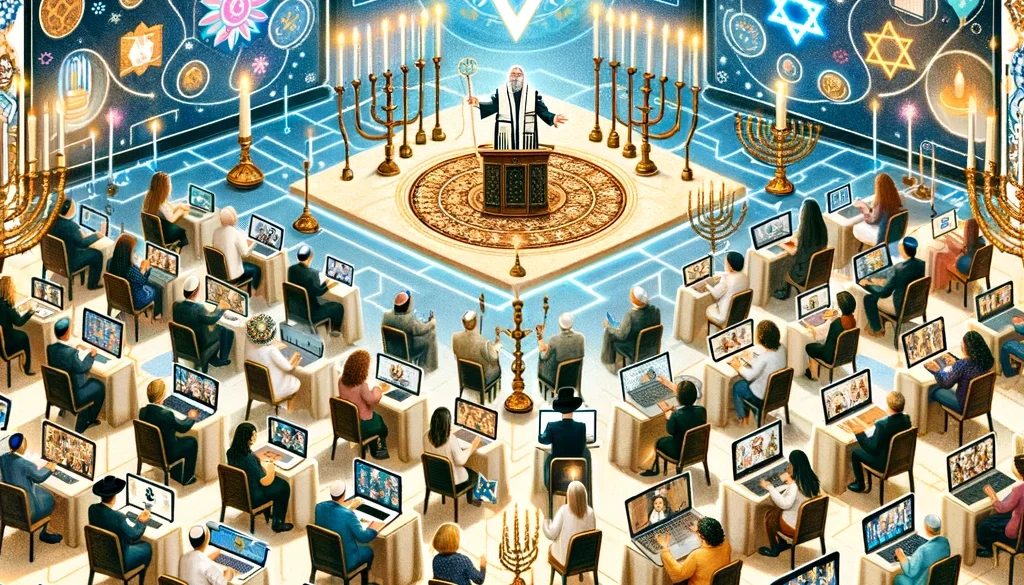How Digital Congregation Are Shaping the Future of Jewish Worship

Introduction
In the ever-evolving landscape of our digital age, religious practices and congregations are experiencing a transformative shift. The concept of the “Digital Synagogue” is not just a futuristic idea but a current reality, mirroring the broader trend of digitalization in society. This shift holds a promise of unprecedented inclusivity, reach, and adaptability in Jewish worship, reshaping the way communities connect, learn, and practice their faith.
what is a digital congregation?
A digital congregation represents a modern evolution of religious community and worship, facilitated through the use of digital platforms and technology. It transcends traditional physical boundaries by creating a virtual space where members of a faith can gather, worship, learn, and interact, regardless of their geographical location.
This innovative approach to congregation leverages live streaming, social media, and other online tools to host services, educational programs, and community events, fostering a sense of belonging and community among participants.
Digital congregations offer the flexibility and accessibility to engage with religious practices and fellow community members in a manner that suits the digital age, ensuring that faith and fellowship can thrive in an increasingly connected world.
The Drive Towards Digitalization
External Factors Accelerating Adoption
From global challenges like pandemics to the everyday convenience of internet access, several factors have accelerated the digital shift. This transition is not merely about coping with restrictions but embracing new opportunities for engagement and community building.
Changing Demographics and Digital Literacy
The demographic landscape of Jewish communities worldwide is changing, with younger generations displaying higher digital literacy and different expectations for community and worship. This shift necessitates a reevaluation of traditional congregation models to stay relevant and accessible.
Advantages of Digital Engagement
Expanding Reach
Digital platforms break down geographical barriers, allowing for a global congregation that brings together individuals from diverse backgrounds, fostering a rich tapestry of Jewish life that transcends physical boundaries.
Fostering Inclusivity and Diversity
Online spaces can offer a welcoming environment for those who have felt marginalized or disconnected from physical communities, including converts, those with disabilities, and people living in areas with limited access to Jewish resources.
Supporting Development and Connection
Digital tools and platforms provide continuous opportunities for learning and spiritual growth, enabling individuals to engage with Jewish teachings and community life on their schedules, fostering a deeper, more personal connection to their faith.
Building Virtual Communities
Engaging and Vibrant Online Communities
Creating a sense of community online requires intentional design and engagement strategies, such as interactive study sessions, virtual Shabbat dinners, and live-streamed services that invite participation and foster a sense of belonging.
The Role of Social Media and Forums
Social media platforms and discussion forums have become vital in facilitating community discussions, sharing resources, and connecting individuals with shared interests and values, further strengthening the communal bond.
Digital Congregation: Opportunities and Benefits
Bridging Geographical Gaps
For Jews living in remote areas or those without a local synagogue, digital congregations offer a lifeline, ensuring that no one is left out of communal worship and activities.
Enhancing Educational Opportunities
Online learning platforms and virtual classes have made Jewish education more accessible than ever, catering to all ages and levels of knowledge, from beginner to advanced.
Engaging Younger Generations
Digital congregations speak the language of the younger generation, utilizing platforms and media they are familiar with to engage them in worship, study, and community service.
Integrating Tradition with Technology
Balancing Traditional Practices
The challenge and opportunity lie in finding meaningful ways to integrate technology without diminishing the richness and depth of Jewish rituals and traditions, ensuring that digital enhancements complement rather than replace the traditional communal experience.
Digital Adaptations of Jewish Rituals
Innovative approaches, such as virtual Passover Seders or live-streamed Yom Kippur services, have shown that it is possible to maintain the essence and communal spirit of Jewish rituals through digital means.
Perspectives Across Denominations
Diverse Views on Digital Congregation
The move towards digitalization has been met with varying degrees of enthusiasm and acceptance across Orthodox, Conservative, Reform, and Reconstructionist denominations, each navigating the balance between tradition and innovation in their ways.
Dialogue and Consensus-Building
Efforts to build consensus and dialogue among the different denominations about digital congregation practices are crucial in fostering a unified approach to embracing technology in religious life.
Ethical Considerations and Privacy
Navigating Privacy and Security
As congregations move online, addressing privacy and data security concerns becomes paramount, ensuring that the digital spaces are safe and respectful of participants’ confidentiality.
Ethical Guidelines for Digital Congregations
Developing and adhering to ethical guidelines is essential in maintaining the integrity of digital congregations, ensuring they remain spaces of respect, inclusion, and dignity.
Looking Ahead: The Role of Rabbis and Leaders
Training and Resources
As digital congregations become more prevalent, providing rabbis and community leaders with the necessary training and resources to effectively lead and engage their communities online is crucial.
Guiding Through Digital Transition
Leaders play a pivotal role in guiding their communities through the digital transition, addressing concerns, fostering engagement, and ensuring that the shift enhances rather than detracts from the communal and spiritual experience.
Conclusion
The inevitable growth of digital congregations presents both challenges and opportunities for Jewish worship and community life. By embracing change while preserving core values and traditions, Jewish communities can ensure that their practices remain vibrant and relevant
